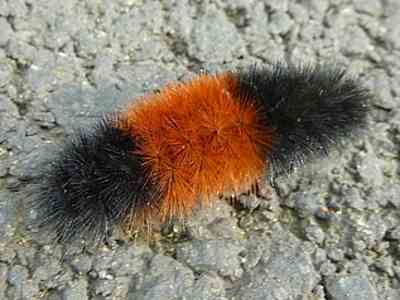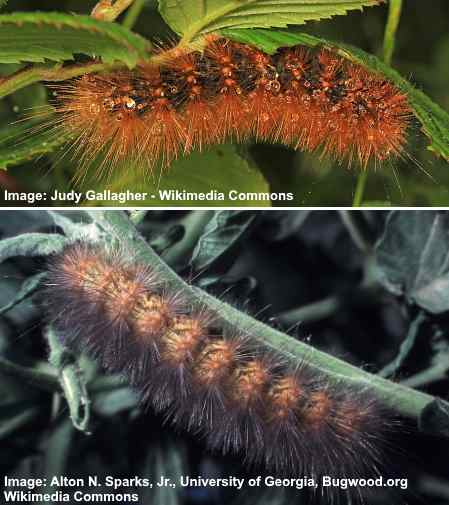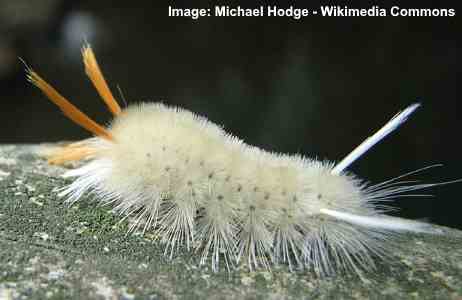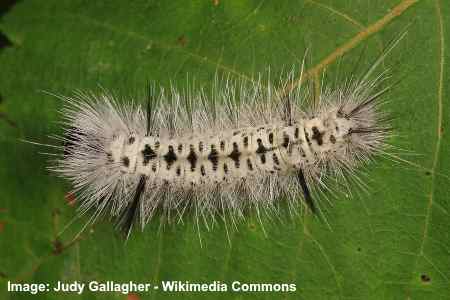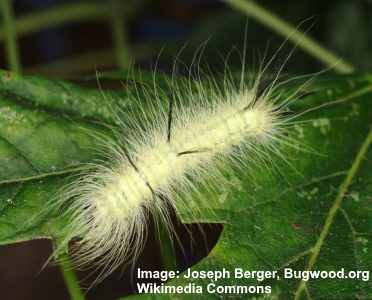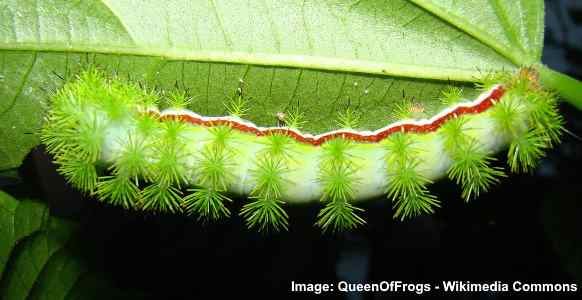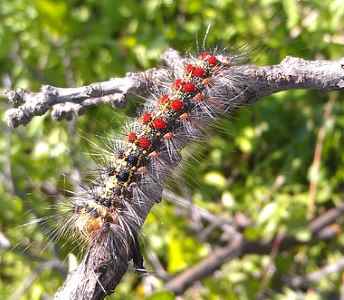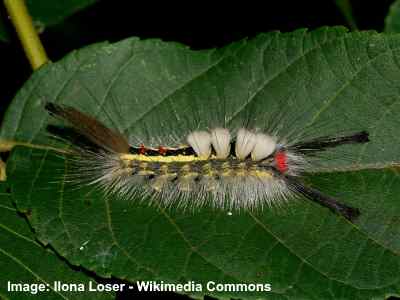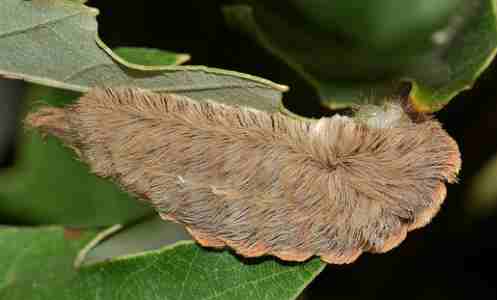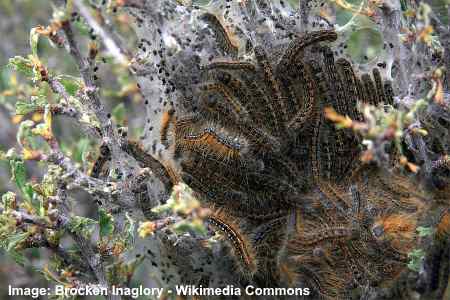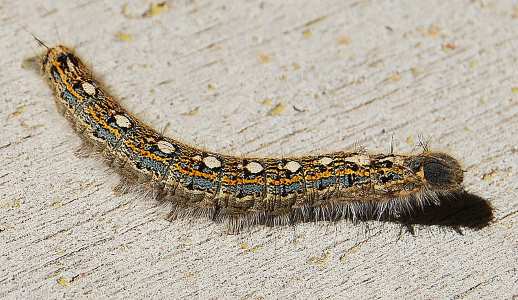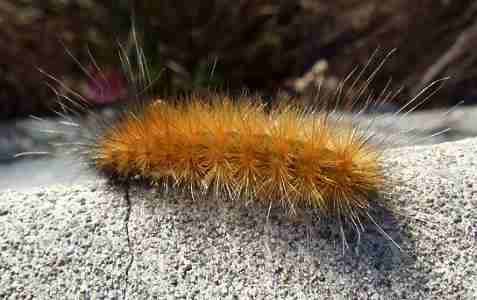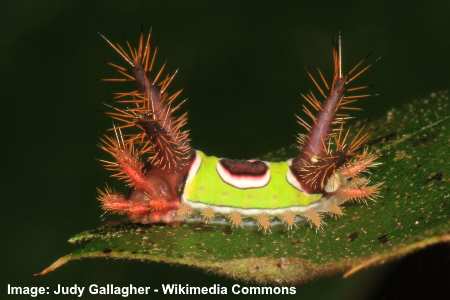17 Furry Caterpillars with An Identification Chart and Pictures
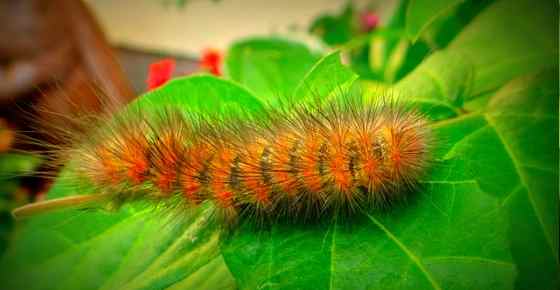
Furry caterpillars are a fascinating type of insect that usually turn into moths. Most types of furry caterpillars feed on the leaves of plants and trees. Although many hairy caterpillars look scary, most are quite harmless. There are some spiky caterpillars that are poisonous and can give you a bee-like sting or cause skin irritation. So, until you identify the exact caterpillar species, you should avoid handling the furry ones without protective gloves.
How to Identify Furry or Fuzzy Caterpillars
Identifying fuzzy caterpillars requires noting their color, type of hairy covering, and specific markings. Some types of furry caterpillars also look deceiving. For example, some woolly caterpillars look like soft furry worms. However, their bristles are a defense mechanism and can be spiky and sore. Although their ‘sting’ won’t cause lasting harm, their poisonous stings can cause allergic reactions in some people.
In this article, you will learn how to identify the various types of common furry caterpillars. In addition, you will find out about the poisonous stinging caterpillars to be aware of.
Types of Furry Caterpillars With Pictures and Names – Identification Guide
The descriptions of the various caterpillars in this list are of mature larvae in their last stage before pupation. After hatching from an egg, the larvae are constantly feeding on plants and growing in size. So, an immature caterpillar may look different from a mature furry one.
Banded Woolly Bear Caterpillar (Pyrrharctia isabella)
The Banded Woolly Bear caterpillar is one of the most common types of furry caterpillars. It’s easy to identify these fuzzy caterpillars due to their dark orange and black markings. The orange and black fuzzy Woolly Bear caterpillar is also called ‘Isabella Tiger Moth,’ ‘Woolybear,’ or ‘Wooly Worm.’ The Banded Woolly Bear caterpillar body is made up of 13 segments.
Although the Banded Woolly Bear caterpillars look like soft furry insects, their body covering is made from bristles that can penetrate your skin. Coming into contact with a black and brown/tan woolly caterpillar can result in skin irritation. However, banded ‘woollies’ are not poisonous.
Some people used to think that Banded Woolly bear caterpillars could predict the severity of winter. A wider orange band in the middle was said to mean that the winter would be mild.
These woolly worms have a diverse diet in the late summer and fall. They feed on various types of grasses and a few flowers like asters, clover and sunflowers.
Identifying features
You can spot banded woolly caterpillars due to the black hairy covering on the ends and a wide brown or tan band of hair in their middle.
Banded woolly bear caterpillars roll up into a ball when they feel threatened.
They grow to just over 2” (5 cm) before the pupal stage and turning into a moth.
- Adult Stage: Isabella tiger moth, a medium-sized moth with orange and black wings
- Caterpillar Feeds on: Various plants, including grasses, clover, low-growing vegetation, and weeds including plantain, dandelion, and nettles
- Habitat: North American forests, fields, and gardens; found throughout the United States and southern Canada
- Stinging: No, they do not have stinging hairs. But the bristles can cause skin irritation but are not poisonous
Salt Marsh Caterpillar (Estigmene acrea)
The Salt Marsh caterpillar is another furry caterpillar that feeds on tomato, cotton, soybean, and cabbage plants. The larvae of the Salt Marsh moth can range in color from pale yellow to dark brown, almost black.
Although the black and brown covering looks spiky, these are soft bristles that aren’t sharp. However, similar to ‘woolly’ caterpillars, the fine hair-like spines can get under your skin and irritate it.
Identifying features
These medium-sized dark brown fuzzy caterpillars grow to just over 2” (5 cm) in length. You can identify these caterpillars apart from Banded Woolly ones because of rows of black spots along their side.
- Adult Stage: Salt Marsh Moth
- Host Plants: Grasses, clover, dandelion, sunflower, and other herbaceous plants
- Habitat and Distribution: Salt marshes, meadows, and other open areas in North and South America
Sycamore Tussock Caterpillar (Halysidota harrisii)
The Sycamore Tussock is an unusual looking white furry and fluffy caterpillar due to 2 hair pencils protruding from each end. A pair of white and a pair of orange long spikes stick out from furry yellowish-white spines. The sides of the larvae have fine white trailing setae (bristly hairs).
As with many types of fuzzy caterpillars, the bristles of Sycamore Tussock are irritating and may cause hives. These are not a stinging caterpillar species and are certainly not a deadly caterpillar variety.
The Sycamore Tussock caterpillar gets its name because it feeds on sycamore trees. This species belongs to the Erebidae family of crawling insects.
Identifying features
Notice a pair of white hair pencils at the rear and a pair of orange hair pencils at the head. These small fuzzy white caterpillars don’t grow longer than 1.1” (3 cm).
- Adult Stage: Sycamore Tussock Moth
- Host Plants: Sycamore, maple, oak, willow, and other deciduous trees
- Habitat and Distribution: Found in eastern North America, particularly in forests, parks, and urban areas
- Stinging: Potential for skin irritation upon contact, may cause mild irritation in some individuals
Hickory Tussock Caterpillar (Lophocampa caryae)
The Hickory Tussock moth caterpillar is also called the ‘Hickory Tiger Moth’ or ‘Hickory Halisidota. This fuzzy caterpillar is a black and white caterpillar species in the same family as the Sycamore Tussock but from the Lophocampa genus.
The Hickory Tussock moth caterpillar is white furry caterpillar that is covered in tufts of white setae. Similar to the Sycamore Tussock, the Hickory Tiger moth caterpillar has a pair of long black hair pencils at each end. The white and black spines may look soft and harmless but they are very irritating. The microscopic hooked ends can cause pain if they get into your eyes or lodged in your skin.
The adult moths of this species emerge during the months of June and July. Following their emergence, the female moths lay their eggs on trees, where they subsequently hatch.
The caterpillars can be observed voraciously feeding on foliage throughout August and September. Fortunately, as most of this feeding takes place during late summer and early fall, it minimally impacts overall plant health. Since deciduous trees and shrubs are naturally preparing to shed their leaves within a few weeks anyway.
When winter arrives, these caterpillars find shelter within their cocoons, often nestled among leaf litter or beneath tree bark.
Identifying features
Black tufts of bristles along the Hickory Tussock caterpillar’s back helps to identify this from the Sycamore Tussock. From above, the black bristles have a diamond shape.
Slightly larger than the Sycamore caterpillar, the Hickory species grow to 1.7” (4.5 cm)
- Adult Stage: Hickory Tussock Moth
- Host Plants: The fuzzy white and black caterpillar of the hickory tussock moth feeds on a wide array of hardwood trees. They
have a particular fondness for birch, quaking aspen, basswood and black locust - Habitat and Distribution: Common in eastern North America, primarily in deciduous forests and wooded areas
- Stinging: Can cause skin irritation upon contact, with the potential for a rash and allergic reactions
American Dagger Moth Caterpillar (Acronicta americana)
Despite its aggressive-sounding name, the American Dagger caterpillar is quite harmless. Its long body is covered in long spindly pale yellow-white hairs, making it look very soft.
Apart from its long yellow-white fluffy hairs, you can recognize the hairy American Dagger caterpillar by its shiny black head. Towards the head end are 2 pairs of long dark hair pencils and a solitary single one at its rear.
You can often find these furry yellowish caterpillars feeding on tree leaves. Favorites of this species include ash, birch, hickory, and oak trees.
Identifying features
You can identify the American Dagger caterpillar due to 5 long black hair pencils. There are 2 near the head and middle, and one on the end. The American Dagger moth caterpillar grows to 2.5” (5 cm) in length.
- Adult Stage: American Dagger Moth
- Host Plants: Various trees including birch, elm, maple, and oak
- Habitat and Distribution: Native to North America, commonly found in forests, woodlands, and urban parks
- Stinging: Contact may result in skin irritation, with some individuals experiencing allergic reactions characterized by itching and redness
Io Caterpillar (Automeris io).
One of the most unusual fat spiky caterpillars is the Io caterpillar. It is covered in tufts of green spikes that look like pine needles. The spines are connected to poison glands. This fuzzy-looking worm is found in Texas, Colorado, Canada, and Florida.
The Io caterpillar has a plump green segmented body with small lime-green tufts. Some of the spiky tufts have black tips. You will also notice a red and white line along the length of its body.
If you spot one of these large green caterpillars, you are best advised to stay clear. The Io caterpillar is a stinging insect and its poisonous spikes will give you a bee-like sting. Although the sting won’t kill you, it can hurt and may even cause an allergic reaction.
Identifying features
Immature larvae start off an orange color before turning bright green in adulthood. The Io caterpillar grows to 2.3” (6 cm) and loves to gorge on tree and plant leaves.
- Adult Stage: Io Moth
- Host Plants: Various trees and shrubs including oak, hickory, and elms
- Habitat and Distribution: Native to North America, particularly in woodland areas and gardens
- Stinging: Has venomous spines that can cause skin irritation, resulting in a painful rash and swelling upon contact
Milkweed Tiger Caterpillar (Euchaetes egle)
The Milkweed Tiger caterpillar is a small furry caterpillar that is found anywhere from Texas to southern areas of Canada.
Also called the Milkweed Tussock moth caterpillar, the larvae are gray and hairy. Black and orange hairy tufts help identify the Milkweed Tussock moth caterpillar. There are also a few white setae tufts that give this caterpillar an interesting color. As the larvae mature, their orange markings become even more pronounced.
As its name suggests, this ‘tussock’ species of caterpillar feeds only on milkweed. This poisonous sap doesn’t affect the caterpillar but acts as a defense against predators.
Identifying features
Black, white, and orange fuzzy hairs cover this caterpillar and it has a black head that is difficult to see. One of the smaller types of caterpillar that only grows to 1.3” (3.5 cm)
- Adult Stage: Milkweed Tiger Moth
- Host Plants: Primarily feeds on milkweed plants
- Habitat and Distribution: Found in North and Central America, particularly in open fields, meadows, and areas with abundant milkweed
- Stinging: Displays warning colors but does not typically sting or cause significant skin irritation in humans
European Gypsy Caterpillar (Lymantria dispar dispar)
Another type of unusual furry caterpillar is the European Gypsy moth. This caterpillar species is found in Europe, Asia, and North America.
This long moth caterpillar has wispy whisker-like setae sticking out in all directions. You can tell this species apart by its bright red and blue dots on its back. These are interspersed with tufts of fine black hairs.
Despite their fuzzy innocent appearance, they are a destructive type of caterpillar. They can quickly destroy large areas of woodland by eating all the tree leaves. Like with most fuzzy caterpillars, their light fine spines can cause contact allergies.
Identifying features of the European gypsy moth caterpillar
Two rows of colorful dots on its back. There are 12 red dots and 10 blue dots. They grow to between 1.5” to 2” (4 – 5 cm).
- Adult Stage: Gypsy Moth
- Host Plants: Various trees including oak, birch, and willow
- Habitat and Distribution: Originally from Europe, now present in North America, particularly in forests and urban areas with trees
- Stinging: Can cause skin irritation, with prolonged contact potentially leading to allergic reactions, itching, and skin rashes
White-Marked Tussock Moth Caterpillar (Orgyia leucostigma)
The White-Marked Tussock caterpillar is an exotic looking caterpillar due to its many identifying features.
Almost every part of this caterpillar has a different color. It has a bright red head with tuft-like antennae on either side. The back of this moth caterpillar has yellow and black stripes running down its length. Just behind the head are 4 bushy white tufts and there are brown and black bushy tails at its end. In addition, there are also fine white tufts of hair along the sides.
Be careful handling these spiky caterpillars as their microscopic barbed spines can cause a lot of irritation.
Identifying features
Different colored tufts of fine hair seem to stick out from all different parts of this caterpillar. A small species of fuzzy caterpillar that grows up to 1.3” (3.5 cm).
- Adult Stage: White-Marked Tussock Moth
- Host Plants: Various deciduous trees and shrubs including oak, cherry, and apple
- Habitat and Distribution: Common in North America, particularly in forests, urban parks, and gardens
- Stinging: Has urticating hairs that can cause skin irritation upon contact, potentially leading to itching and a rash
Southern Flannel Moth (Asp) Caterpillar (Megalopyge opercularis)
Southern Flannel moth caterpillars, also known as asps, are small, venomous, and covered in dense hair. They can be found in southern states such as Texas and Florida.
Asp caterpillars are covered in setae that look like messy beige-orange hair. Some say that this species looks like a tiny Persian cat. Some species have vibrant orange ‘hair’ and others have a grayish or beige speckled black appearance. Also, some types of this woolly caterpillar have orange line running down each side. You may even find some with lemon-yellow fluffy hair with a long hairy tail.
As the caterpillars mature to pupation, the hairy appearance becomes more disheveled. Longer straggly orange or brown hairs start to grow out from the sides.
Under the soft fluffy hairs are sharp and stiff spines that are attached to poison glands. When touched, these venomous spines break off in the skin and cause severe pain.
The Southern Flannel moth caterpillar is also called a puss moth caterpillar, woolly slug, or Italian asp.
Identifying features
One of the fluffiest beige or orange caterpillars you will find. Being a medium-sized caterpillar, Southern Flannels grow to between 1.3” and 3” (3.5 – 4 cm) long.
- Adult Stage: Southern Flannel Moth
- Host Plants: Various trees and shrubs including oak, hickory, and elm
- Habitat and Distribution: Found in the southern United States, primarily in forests, urban parks, and gardens
- Stinging: It is considered dangerous due to its nasty sting. The toxicity of the caterpillar’s sting increases with its body size. Symptoms from the sting of the caterpillar can vary in severity and may include headache, nausea, fever, and seizures. In addition, touching them can cause a burning sensation and a rash.
Western Tent Caterpillar (Malacosoma californicum)
Another large black furry caterpillar is the Western Tent species. This type of caterpillar is from the Lasiocampidae family and is one of 6 subspecies in the family.
This tent caterpillar species has a long black and orange body. Fine orange or dark yellow spines cover the body giving it a slightly furry look. However, some varieties of Western Tent caterpillars can be gray or white with an orange stripe. Another feature that identifies Western Tent caterpillars is their pale blue head.
The damage caused by the Western Tent Caterpillar occurs during the spring months, particularly from late April to early June. This caterpillar species is known for forming conspicuous silk tents in the branches of host trees. The larvae feed on the leaves of various trees, which can result in defoliation if the infestation is severe.
Identifying features
An orange stripe and fine orange hairs running down the length of this caterpillar help to identify it. The destructive larvae can grow up to 2.5” (5 cm) long.
- Adult Stage: Western Tent Moth
- Host Plants: Various trees including cottonwoods, willows, and fruit trees
- Habitat and Distribution: Native to western North America, commonly found in forests, woodlands, and riparian areas
- Stinging: No significant reports of stinging or causing skin irritation in humans.
Eastern Tent Caterpillar (Malacosoma americanum)
Another black furry tent caterpillar is the Eastern Tent caterpillar. This looks similar to its Western cousin but has a distinct white stripe running down its back.
Looking closely at this caterpillar, you will also notice distinctive blue markings on its side. What makes this a hairy type of caterpillar is the tufts of fine spines just below the light blue markings. These fine hairs can be any shade of color from silvery-white to light brown.
These caterpillars love to build their tents on crab-apple, aspen, willow, and mahogany trees.
Identifying features
Thin tufts of silky hairs on a black body with white stripes help to differentiate these caterpillars from other tent species. One of the larger species of tent caterpillars, the Eastern tent species grows up to 2.3” (6 cm).
- Adult Stage: Eastern Tent Moth
- Host Plants: Various trees including cherry, apple, and hawthorn
- Habitat and Distribution: Found in eastern North America, particularly in forests, woodlands, and urban areas with suitable host trees
- Stinging: No significant reports of stinging or causing skin irritation in humans.
Forest Tent Caterpillars (Malacosoma disstria)
Forest Tent caterpillars are similar in appearance to their Eastern and Western cousins. They are similar in size with tufts of fine hair running down the length of their body.
One of the identifying features of Forest caterpillars is their white footprint-shaped markings on each segment. These white marks run up the back of the caterpillar. Also, light blue segmented stripes are on the sides of this crawling larvae.
Unlike other species of tent caterpillars in the Malacosoma genus, these larvae don’t live in tents.
For most people, these types of caterpillars don’t pose any problems. However, if you have sensitive skin, you may get itchy red patches of skin irritation after handling one. The same is true of other tent caterpillars.
Identifying features
Markings that look like white footprints and blue and yellow stripes help identify this type of caterpillar. As with other tent caterpillars, the ‘Forest’ variety grows up to 2.3” (6 cm).
- Adult Stage: Forest Tent Moth
- Host Plants: Various deciduous trees including aspen, birch, and maple
- Habitat and Distribution: Common in North America, particularly in forests and wooded areas
- Stinging: No significant reports of stinging or causing skin irritation in humans
Fall Webworms (Hyphantria cunea)
Fall Webworms caterpillars look both hairy and spiky at the same time. The interesting feature of Fall Webworms is that they come in a wide range of colors. Some of these small fuzzy caterpillars can be pale yellow with black dots, and others can be dark gray with light markings. Each segment of these insects has a wart that sprouts tufts of fine hairs. These can be yellow to white in color.
These yellow hairy caterpillars love to munch their way through leaves on walnut, cherry, crab-apple, and other deciduous trees.
Identifying features
Fuzzy yellow and black caterpillars with long tufts of setae sticking out from their sides. One of the smallest of the furry caterpillars that only reaches 1” (2.5 cm) in length.
- Adult Stage: The adult fall webworm moth is a white moth with small black spots on its wings.
- Caterpillar Feeds on: The caterpillar feeds on the leaves of a wide range of deciduous trees and often creates silken web nests.
- Habitat: These caterpillars can be found in gardens, orchards, and woodlands.
- Stinging: No, they do not have stinging hairs.
Yellow Woolly Bear Caterpillar (Spilosoma virginica)
One of the most common caterpillars you can find is the Yellow Woolly Bear. This subspecies of the Erebidae family of caterpillars has a very furry appearance. It is also called the Virginia Tiger moth.
The Yellow Woolly bear can be any shade of color, not just yellow. It is not common to find beige ‘Yellow Woollies,’ black and yellow ones, or bright orange-colored caterpillars. Yellow Woolly caterpillars tend to feed on almost any type of plant. So, you can find these spiny ‘yellow’ caterpillars munching away on greenery in nearly every place.
Soft bristles cover the body similar to their cousin, the Banded Woolly Bear caterpillar.
Identifying features
Yellow Woolly larvae have just one color of fluffy hairs rather than being a multicolored type of caterpillar. These large fluffy caterpillars grow to around 2” (5 cm) long.
- Adult Stage: Virginian Tiger Moth
- Host Plants: Various plants including dandelion, nettle, and sunflower
- Habitat and Distribution: Common in North America, particularly in open fields, meadows, and gardens
- Stinging: No significant reports of stinging or causing skin irritation in humans.
Saddleback Caterpillar (Acharia stimulea)
One of the scariest spiky types of caterpillar has to be the Saddleback caterpillar. This caterpillar species gets its name from the green saddle-like markings on its back.
The head of the Saddleback caterpillar has two menacing eye-like markings. Each end of the larva has spiky brown horns that look dangerous to touch. In fact, this is a stinging caterpillar.
The sting from Saddlebacks come from the urticating spines on the horns and rest of its body. These venom-filled hairs can cause a painful sting resulting in a rash and possible nausea.
Identifying features
The identifying feature of the Saddleback is a saddle-like marking on its back. This is a square green patch with a large brown oval central area that is usually bordered with white. The end of the caterpillar also has 2 white dots that resemble menacing eyes.
- Adult Stage: Saddleback Moth
- Host Plants: Various trees and shrubs including elm, apple, and oak
- Habitat and Distribution: Found in North America, particularly in forests, woodlands, and urban parks
- Stinging: Has venomous spines that can cause skin irritation upon contact, resulting in a painful rash and localized swelling.
Drinker Moth Caterpillar (Euthrix potatoria)
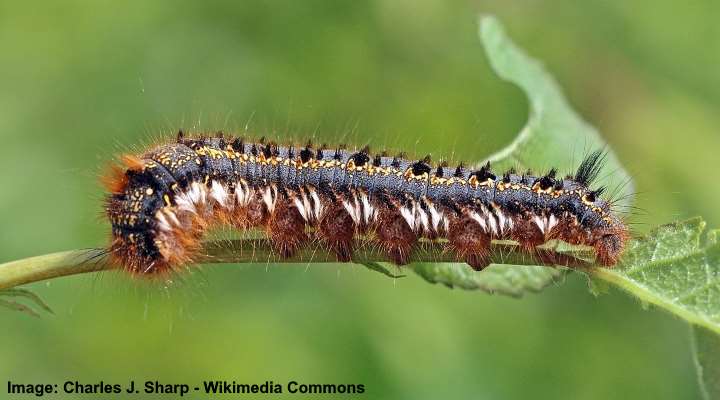
Drinker Moth Caterpillar (Euthrix potatoria)
The Drinker Moth caterpillar has a distinctive appearance, characterized by a dense covering of long, soft hairs. It typically has a black and brown body with tufts of orangey hairs, two rows of yellow or orange dots along its back, and white markings running down its sides. Depending on the climate, the caterpillar’s coloration may appear as a combination of black and orange. The Drinker Moth caterpillars can grow up to 2.4 inches (61 mm) in length.
The Drinker Moth caterpillar reaches its full size by May or June and can occasionally be spotted basking in the sun on stone walls and wooden posts.
- Adult Stage: Drinker Moth. It has a robust body with broad wings, displaying a distinctive pattern of brown and cream-colored scales. It typically has a wingspan of around 45-60 millimeters.
- Host Plants: The caterpillars of the Drinker Moth feed primarily on various grasses, including common reed and other aquatic plants.
- Habitat and Distribution: This species is often found in damp or wet habitats, such as marshes, fens, and grassy areas near water bodies, across Europe and parts of Asia.
- Stinging: The caterpillars of the Drinker Moth are not known to be significantly stinging or causing skin irritation in humans. However, handling them with bare hands can occasionally cause mild irritation or an allergic reaction in sensitive individuals.
Furry Caterpillars – Frequently Asked Questions
Are caterpillars insects?
Yes, caterpillars are moths and butterflies in their larval stage and belong to the class of Insecta. Before turning into beautiful flying insects, caterpillars enter a pupal stage where they undergo metamorphosis.
Do furry caterpillars sting?
Only a few furry caterpillars have stinging capabilities. However, the majority of hair-covered caterpillars cause skin irritation, contact dermatitis, or hives.
Are caterpillars worms?
Although they may look like furry poisonous worms, caterpillars are not worms. They belong to the Lepidoptera order of insects, whereas worms are not classed as an insect at all.
How to identify venomous furry caterpillars?
It can be difficult to know exactly which caterpillars are venomous and which aren’t. That is why it’s important to use an identification chart to learn about venomous caterpillars. Usually, brightly-colored and hairy caterpillars have some amount of irritating venom in them.
Do furry caterpillars turn into moths or butterflies?
Most furry caterpillars become moths after they emerge from the pupa.
Why are some caterpillars hairy?
Spiky hairs surrounding certain species of caterpillars act as a defense mechanism. Their furry spines either contain some poison or they cause irritation to animals and birds that prey on them.
Related articles:
- Black Caterpillar Identification and Guide
- Types of Green Caterpillars with Identification Guide
- Stinging Caterpillars Identification Guide

